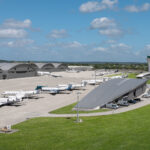Airbus is exploring a range of options for how it will incorporate liquid hydrogen tanks on board its aircraft as part of the ZEROe programme.
Speaking at the AIRTEC aerospace fair in Augsburg, southern Germany, Tanja Neuland, Hydrogen Techno IPT Leader at Airbus, said three concrete options were being looked at.
These include a ‘podded’ configuration with tanks fixed to the wings, a ‘dorsal’ option with tanks throughout the fuselage, and a ‘caudal’ option with tanks at the rear of the fuselage.
“Each of them has pros and cons. I am leaning more towards the caudal area, but there are still challenges with that.
“We could have a side by side configuration where you have tanks near to each other, or two tanks one behind the other.”
ZEROe project
Airbus’ ambition is to bring to market the world’s first hydrogen-powered commercial aircraft by 2035.
To get there, their ZEROe project is exploring a variety of configurations and technologies, as well as preparing the ecosystem that will produce and supply the hydrogen.
One of the issues with hydrogen is its low volumetric energy density.
Airbus says that at normal atmospheric pressure and ambient temperature, you would need approximately 3,000 litres of gaseous hydrogen to achieve the same amount of energy as one litre of kerosene fuel.
One alternative is to pressurise the hydrogen at 700 bars, or to reduce the temperature to -253°C when hydrogen transforms itself from a gas to a liquid, increasing its energy density.
Neuland added: “One challenge is the infrastructure. Even if we solve the technology we will still need the support from government and airports.”
Rolls-Royce has already proven that hydrogen could power a jet engine following successful ground tests in 2022.
Many smaller operators are also making progress on hydrogen-powered aircraft, including ZeroAvia and Universal Hydrogen who have carried out flight tests.Subscribe to the FINN weekly newsletter

